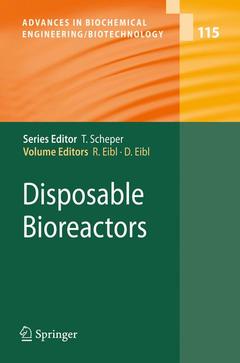Description
Disposable Bioreactors, 2010
Advances in Biochemical Engineering/Biotechnology Series, Vol. 115
Coordinators: Eibl Regine, Eibl Dieter
Language: English
Subjects for Disposable Bioreactors:
Publication date: 03-2012
226 p. · 15.5x23.5 cm · Paperback
Publication date: 11-2009
226 p. · 15.5x23.5 cm · Hardback
Description
/li>Contents
/li>Comment
/li>
René Brecht: Disposable Bioreactors: Maturation into Pharmaceutical Glycoprotein Manufacturing.- Xiaowei Zhang, Matthieu Stettler, Dario De Sanctis, Marco Perrone,Nicola Parolini, Marco Discacciati, Maria De Jesus, David Hacker,Alfio Quarteroni, and Florian Wurm: Use of Orbital Shaken Disposable Bioreactors for Mammalian Cell Cultures from the Milliliter-Scale to the 1,000-Liter Scale.- Regine Eibl, Sören Werner, and Dieter Eibl: Bag Bioreactor Based on Wave-Induced Motion: Characteristics and Applications.- Regine Eibl and Dieter Eibl: Application of Disposable Bag-Bioreactors in Tissue Engineering and for the Production of Therapeutic Agents.- Jean-Paul Ducos , Bénédicte Terrier, and Didier Courtois : Disposable Bioreactors for Plant Micropropagation and Mass Plant Cell Culture.- Gerardo Catapano, John F. Patzer II, and Jörg Christian Gerlach : Transport Advances in Disposable Bioreactors for Liver Tissue Engineering.- Anne Glindkamp, Daniel Riechers, Christoph Rehbock, Bernd Hitzmann,Thomas Scheper, and Kenneth F. Reardon: Sensors in Disposable Bioreactors Status and Trends.- Uwe Gottschalk: Disposables in Downstream Processing.- Aline Ravisé, Emmanuelle Cameau, Georges De Abreu, and Alain Pralong: Hybrid and Disposable Facilities for Manufacturing of Biopharmaceuticals: Pros and Cons.




